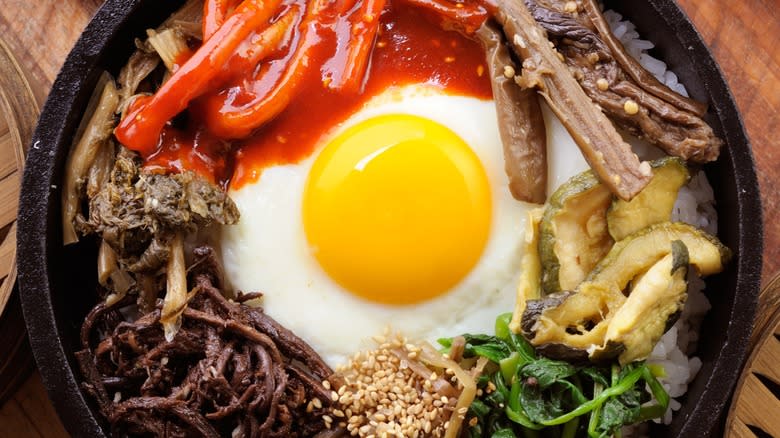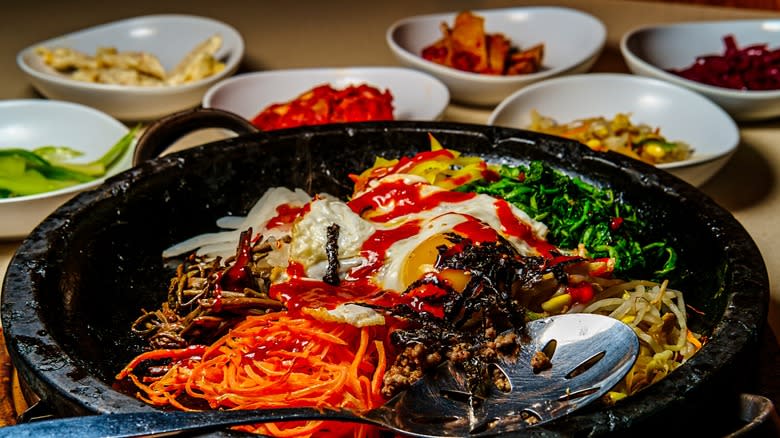A Sheet Pan Makes Bibimbap Even Easier

The Korean dish with the fun name is also one of the most popular among Americans. We love bibimbap, maybe because of our penchant for things in bowls, or possibly because we can't get enough of the flavors that are intrinsic to Korean cuisine. Traditional bibimbap is a combination of steamed white rice, vegetables (spinach, soy bean sprouts, carrots, and bell peppers), toasted sesame oil, gochujang (Korean red chili paste), and a sunny side up egg.
This is a variation on a vegetarian bibimbap recipe, but the addition of thinly sliced bulgogi beef is also widely served. There are regional versions of bibimbap that include everything from raw, sliced beef to various types of fish or seafood, and vegetables such as sweet potato, kale, mushrooms, or zucchini. Translated from Korean, "bibimbap" combines the word "bibim," meaning "mix together," and "bap," which translates to "cooked rice." And indeed, the dish is traditionally mixed thoroughly before it's eaten.
Whatever your preference for ingredients, there are a lot of them -- and the traditional way to cook this beloved dish takes some time, calling for cooking each component separately. We found an easier way to put together bibimbap: Cook your vegetables and other additions on a sheet pan all at once. Then, you need only to add the rice and egg to the bowl once all other elements are cooked. Rather than blanching or sautéeing the different veggies separately, roasting them is a much faster solution, and the ingredients take on a richer, more caramelized profile. Once everything for your bibimbap is cooked, you're ready to add the raw veggies and fried egg.
Read more: 25 Delicious Ways To Use Up Leftover Rice
How To Cook And Assemble A Sheet Pan Bibimbap

Choose your vegetables for baking, and cut them around the same size to ensure even roasting. You can select mushrooms, sweet potato, carrots, zucchini, kale — anything that roasts well works great. Preheat your oven to 400 degrees Fahrenheit and prepare your rice however you typically cook it. Steaming in a rice cooker is a simple and quick way to get good results for white rice. Next, coat the veggies with vegetable or canola oil.
For a beautiful and traditional presentation of bibimbap, the different veggies should be grouped separately in the bowl when served, so coat the veggies by type and arrange them in quadrants on your sheet pan. Bake for 30 minutes, turning each quadrant halfway through. With your veggies roasted and your rice cooked, it's time to assemble the bibimbap. Add rice to a bowl and carefully place the fried egg on top of the rice. Next, place your roasted vegetables in a circle around the egg.
For an authentic Korean experience, add banchan to the bibimbap. Banchan is the name for the requisite small side dishes that accompany Korean food. Types of banchan include soybean sprouts, pickled daikon radishes, spicy cucumber salad, and the best banchan to try for beginners, kimchi. Drizzle your bibimbap with some sesame oil, sprinkle sesame seeds, and add a splash of gochujang to complete the sheet pan bibimbap. All that's left to do is to mix together all the beautiful flavors and enjoy.
Read the original article on Tasting Table.


